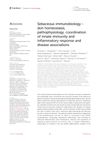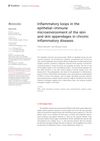IL-36γ Drives Skin Toxicity Induced by EGFR/MEK Inhibition and Commensal Cutibacterium Acnes
December 2019
in “
The Journal of clinical investigation/The journal of clinical investigation
”
TLDR A protein called IL-36γ causes skin side effects from certain cancer treatments when combined with a common skin bacteria.
In 2020, researchers discovered that the inflammatory molecule IL-36γ, in conjunction with the skin bacterium Cutibacterium acnes, was a significant factor in skin toxicity caused by EGFR/MEK inhibitors, a treatment for various cancers. The study found that these inhibitors, along with Cutibacterium acnes, induced the production of IL-36γ in keratinocytes, leading to skin inflammation and hair loss. The transcription factor KLF4 was identified as a key regulator of IL-36γ transcriptional activity in response to EGFR inhibition. The study also revealed that the mouse IL-36γ promoter lacks the KLF4 binding site found in humans, suggesting that mice may not be an appropriate model for studying EGFRi-induced acneiform skin toxicity. The findings suggested that IL-36γ and KLF4 could be potential therapeutic targets for managing skin toxicities caused by EGFRi/MEKi. The number of participants in the study was not mentioned.




